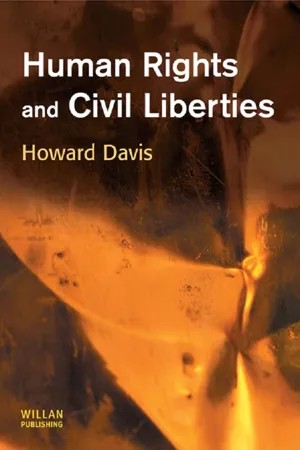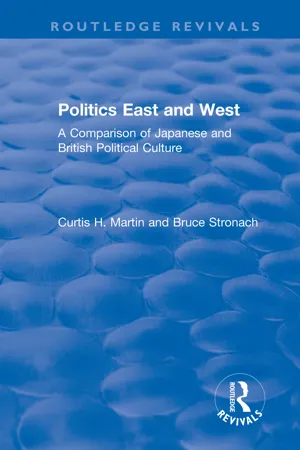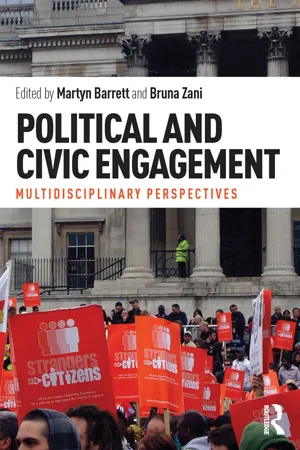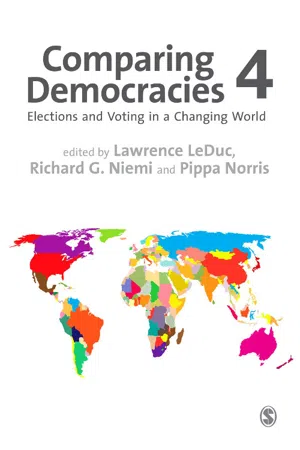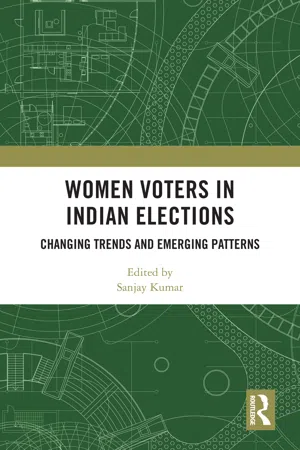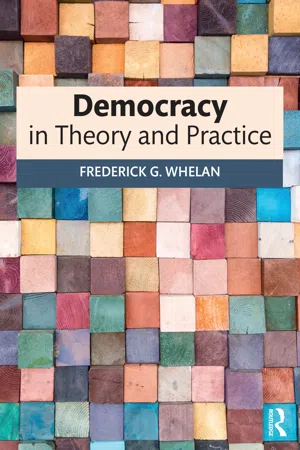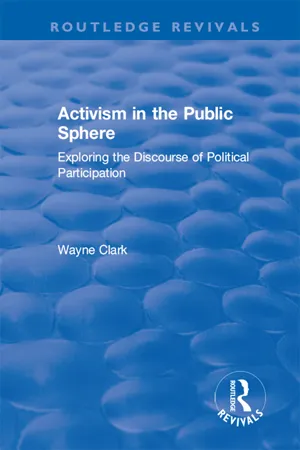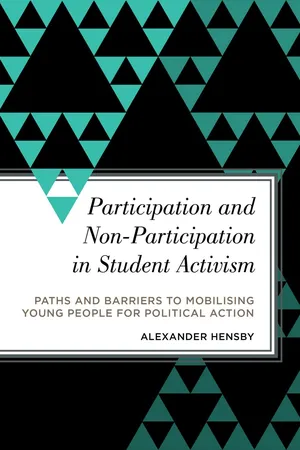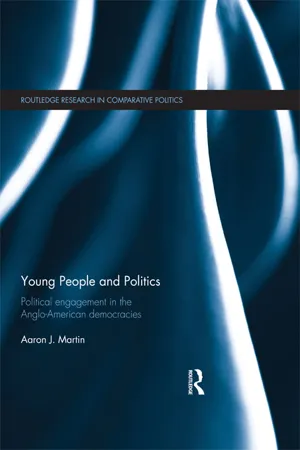Politics & International Relations
Political Participation
Political participation refers to the active involvement of individuals in the political process, such as voting, joining political parties, or engaging in political activism. It encompasses various forms of citizen engagement in decision-making and governance, contributing to the functioning of democratic societies. Political participation is essential for shaping public policies and holding elected officials accountable.
Written by Perlego with AI-assistance
Related key terms
Related key terms
1 of 4
Related key terms
1 of 3
12 Key excerpts on "Political Participation"
- Maria Grasso(Author)
- 2016(Publication Date)
- Routledge(Publisher)
Parry et al. (1992: 16) hold that participation includes “actions by citizens which are aimed at influencing decisions which are, in most cases, ultimately taken by public representatives and officials”. For Clarke et al. (2004: 219), participation is “a voluntary activity done by an individual acting alone or with others … a means by which citizens express their political attitudes, beliefs and opinions”, and that which “requires resources or skills, conveys information to public officials, and is purposive, that is, it attempts to achieve goals or implement policies”. Definitions of Political Participation therefore include some element of action, however, the category can be ambiguous. For example, in their seminal study, Almond and Verba (1963) treated political discussion as one of many forms of Political Participation. Similarly, Barnes and Kaase (1979) grouped political discussion under the heading of ‘Political Participation’, together with reading about politics and working with parties and voluntary organisations. Verba et al. (1978: 46) further posited an important distinction between: (1) political interest, measured through subjective reported levels, or via indirect utterances in terms of political discussion, and (2) Political Participation proper, or those activities directed at influencing the processes of government. Therefore, political involvement comprises two related but distinct dimensions. On the one hand lies Political Participation, constituted by those activities that supplement the established democratic representative process. On the other hand lies political interest, “the degree to which politics arouses a citizen’s curiosity” (Van Deth 1990: 278), understood in terms of subjective political interest (Van Deth and Elff 2000: 2). Verba et al. (1995: 39) stress that they “focus on activity: we are concerned with doing politics, rather than with being attentive to politics”- eBook - ePub
- Howard Davis(Author)
- 2013(Publication Date)
- Willan(Publisher)
13 Political Participation and electoral politics
DOI: 10.4324/9781843924548-1313.1 Political Participation
The right of people to participate in public affairs is fundamental to a reasonable democracy. For most people it is predominantly through the processes and institutions of representative politics that such participation takes place. Voting in elections for the House of Commons, the European Parliament, for one of the devolved legislative bodies or for a local council is a fundamental, though in many ways, minimal means of participation. For those who are or wish to be politically active, there should also be in a democracy the freedom to be a candidate in elections and, if successful, a member of the representative body to which elected. Similarly the politically active should not be denied, by arbitrary or unreasonable laws, the right, if properly selected, to be a member of the government or a local council or a devolved executive.As indicated in Chapter 3 , public life in the United Kingdom is conducted by a large range of organisations of various kinds and of various degrees of independence from central government. Appointment to such bodies is normally within the patronage of a minister or the discretion of a professional body, for example, though they may be supervised by an appointments commission. Few such bodies are in any way directly or even indirectly elected. They may have to consult with the public but are not in any direct way subject to public censure or recall. While fundamental rights to vote and to stand for representative bodies are widely recognised, rights of wider participation are much less clear.13.1.1 International law
International law recognises the value of political activity in an effective, pluralist democracy. Predominantly such activity is protected by fundamental rights of expression and political association and assembly. A wider, rather abstract right to Political Participation is also recognised. Article 25 of the International Covenant on Civil and Political Rights establishes rights not only to vote and be elected and to have equal access to public service but also declares that ‘every citizen shall have the right and the opportunity … to take part in the conduct of public affairs, directly or through freely chosen representatives’. A broad conception of public affairs is meant which includes the exercise of legislative, executive and administrative power and includes all aspects of public administration.1 However, it seems that little that is specific is required under the Article. No particular political system is required, there is no attempt to identify the kinds of public body that ought to be elected and, in any case, this part of Article 25 is understood to be ‘programmatic’, merely identifying aspirations,2 - eBook - ePub
Politics East and West: A Comparison of Japanese and British Political Culture
A Comparison of Japanese and British Political Culture
- Curtis H. Martin, Bruce Stronach(Authors)
- 2017(Publication Date)
- Routledge(Publisher)
In surveys, conventional political behavior is often defined by seven behaviors: reading about politics in the papers, discussing politics with friends, working on community problems, contacting politicians and public officials, convincing friends to vote as one's self, participating in an election campaign, and attending political meetings. But these by no means exhaust the possibilities, and arguably reading about and even discussing politics might better be included under the rubric of interest in politics. Other activities, of course, could and should also be included. Voting is regarded as the classic participant role. Party and other organizational memberships, officeholding in public or private organizations, political speech making, and many other activities might be indicative of conventional participation. We would argue that citizens seeking redress from government are participating, too. In fact, since such activities normally require a high degree of motivation, information, and political skills, they might well be classified as a relatively high order of political activity though they are seldom given attention in the literature on participation. Our discussion below is deliberately eclectic, seeking to apply a broad and inclusive definition of participation. We consider specifically and in a degree of detail, participation through party membership and identification, and through voting, and, in less detail, other forms of participation.Partisan Identification and Party Membership
Party membership and identification constitute a major form of participation in many countries. Particularly at early stages of the evolution of modern democratic development, parties were critical engines of political mobilization, acting as intermediaries between elites and voters. The electorate generally lacked education and political skills. As Inglehart and Klingemann (1979: 207) put it, parties and other "elite-directed" institutions such as church and union "were effective in bringing large numbers of newly enfranchised citizens to the polls in an era when universal compulsory education had just taken root." "Political Participation," they wrote, "remained relatively dependent on permanently established organizations as long as most people lacked organizational skills." According to them, however, rising levels of education and political skills in the twentieth century have created conditions for a second path to mobilization—an "elite challenging mode." It is this mode that has been identified as the "new politics" of direct action. In this more populist style of politics, "ad hoc organizations can be brought into being in response to any current political issue because the public has an unprecedentedly large leavening of potential counter-elites. Effective boycotts, demonstrations, and similar activities can be organized and publicized by skilled amateurs, acting outside established channels" (Inglehart and Klingemann 1979: 208). Dalton's "mass mobilization typology" further distinguishes between these two principal, but different sources of mobilization to political action: the first, he calls "partisan" and the second "cognitive." Partisan mobilization occurs when parties provide political cues to citizens. Cognitive mobilization occurs when citizens develop the necessary skills "to orient themselves to politics without depending on party labels." Like Inglehart and Klingemann, Dalton (1984: 271) associates cognitive mobilization (their "elite challenging participation") with the generally rising levels of education and political sophistication in industrial countries, and with a psychological involvement in politics that is absent in the case of partisan mobilization. "When citizens of these countries [that are low in cognitive mobilization] become mobilized into politics, it is largely through partisan channels" (Dalton 1984: 271; and see Inglehart 1970). - eBook - ePub
Political and Civic Engagement
Multidisciplinary perspectives
- Martyn Barrett, Bruna Zani(Authors)
- 2014(Publication Date)
- Routledge(Publisher)
electoral participation (cf. Brady 1999; van Deth 2001). For a long time, voting was perceived as the primary way for a citizen to make his or her voice heard in the political system, and voting turnout has been described as the most commonly used measure of citizen participation in the US. When postwar American political scientists thought about Political Participation, they quite simply thought about acts intentionally aimed at influencing governmental decisions (Verba and Nie 1972; Easton 1953: 134). A frequently cited definition by Verba and his associates, from the 1970s, testifies to the focus on the election of political leaders and the approval of their policies:By Political Participation we refer to those legal acts by private citizens that are more or less directly aimed at influencing the selection of governmental personnel and/or the actions that they take.(Verba et al . 1978: 1)Other often-cited definitions from the same era are quite similar: Political Participation was understood as the ‘actions of private citizens by which they seek to influence or support government and politics’ or as ‘all voluntary activities by individual citizens intended to influence either directly or indirectly political choices at various levels of the political system’ (Milbrath and Goel 1977: 2; Kaase and Marsh 1979: 42).At the same time, Verba and others admitted that all allocations of values in society are not determined by political elites alone – private and civil society actors could also fulfil this function. Still, most political scientists at the time were not really interested in civic engagement in the wider sense or in how citizens acted in relation to social elites outside of the political domain; rather, it was a matter of pointing out that citizens could also , in addition to voting, participate in politics between elections (Verba et al . 1978: 47).This way of thinking about Political Participation at least implicitly opened up analyses of activities that included not only voting behaviour, but also, for example, demonstrations, strikes, boycotts and other forms of protest behaviour. This line of thought was also quite early on followed by Barnes and Kaase in their seminal work on Political Action (Barnes and Kaase et al . 1979; Kaase and Marsh 1979; cf. Verba and Nie 1972; Verba et al . 1995; Montero et al . 2007: 434). Consequently, actions directed against all political, societal, media or economic actors (or elites) could be analysed as ‘Political Participation’ (Teorell et al - eBook - ePub
Comparing Democracies
Elections and Voting in a Changing World
- Lawrence LeDuc, Richard G Niemi, Pippa Norris(Authors)
- 2014(Publication Date)
- SAGE Publications Ltd(Publisher)
In a democratic political system citizens ultimately decide on the authoritative allocation of values within their society. In a system of direct democracy, this can imply that citizens themselves make the decisions, as in town hall meetings or by means of a referendum. In practice, however, these kinds of decision-making procedures are quite limited in modern, large-scale societies. Furthermore, we also know that while small-scale gatherings might seem the hallmark of democracy, in practice inequalities do occur, as a result of seniority, gender, or rhetorical skills (Bowler et al. 1998). While internationally there is a tendency toward more frequent use of referenda, in practice only a limited proportion of all political decisions are taken in this manner (LeDuc 2003). Often, referenda are focused on a yes/no question, and this might make it more difficult to reach a compromise or a more gradual solution in complex policy issues. The protection of minority rights might also be a problem in decisions that are made with a referendum. A country like Switzerland is perhaps the best known and most traditional example of a political system that frequently relies on referenda. In 2012, for example, 12 national referenda were held in that country. This still means that a vast majority of political decisions in Switzerland were made by elected politicians. Furthermore, for most referenda, turnout is less than 50% of eligible citizens. Taking part in referenda apparently is not a routine matter, not even in a country like Switzerland (Kriesi 2005).In contemporary societies, most Political Participation takes place in the context of representative democracy, with politicians who are elected by citizens and are responsible for the bulk of all political decisions. A routinely used definition of Political Participation clearly can be situated within the framework of representative democracy: “Political Participation affords citizens in a democracy an opportunity to communicate information to government officials about their concerns and preferences and to put pressure on them to respond” (Verba et al. 1995: 37). Three elements are important in this definition. First, participation can be seen as a flow of information from citizens to public officials. Like any other form of communication, this means sender, information, and receiver can be distinguished and it implies that an act that would be performed in complete isolation, without anyone ever knowing it has happened, cannot be included in this definition. The participation act has to be targeted toward officials: whether or not they actually pick up the information, let alone act on it, falls outside the scope of the definition: unsuccessful acts of participation obviously still should be seen as Political Participation. Second, participation is based on preferences about political decision-making. These preferences can apply both to the person who should make the decisions, and on the content or the timing of these decisions. It can also apply to the topics on which decisions should be taken (agenda-setting), as in recent decades the scope of government intervention and political decision-making has been expanded considerably. Preferences can be both negative and positive, which implies that a demonstration in favor of a political regime can be seen as participation just as well as a strike against the current regime. Third, the element of pressure is important in this definition: participation is not just sending out information (as in a survey or an opinion poll), but simultaneously citizens exert pressure on decision-makers. This pressure can be explicit (e.g., violent demonstrations) or implicit (e.g., the threat that politicians will lose electoral support if they do not comply with the demands of demonstrators). Participatory acts are more likely to have an effect if they show a “disruptive potential,” i.e., the capability to disrupt the routine functioning of the political system or society as a whole (Piven and Cloward 1977). - eBook - ePub
Women Voters in Indian Elections
Changing Trends and Emerging Patterns
- Sanjay Kumar, Sanjay Kumar(Authors)
- 2021(Publication Date)
- Routledge India(Publisher)
The Subjection of Women and who supported their citizenry rights and legal equality. This book became a touchstone for forthcoming women’s movements demanding their citizenship rights. After a long struggle, women attained the legal voting right and started taking part in political activities.However, Political Participation is not merely taking part in elections. It is much wider in nature and ranges from active participation such as voting in elections, contesting elections, door-to-door canvassing for a party or a candidate and donating or collecting money to passive participation such as listening to the political news, discussing politics with friends, attending political rallies, writing petitions and getting in touch with public institutions. Citizens also participate in political systems by joining various political and non-political organizations. These citizenry actions and people’s participation in democracy and governments were well conceptualized by Robert Putnam (1993) as ‘civic engagement’, which he believed was important for economic development and effective governance.Using the intensity and regularity of citizen’s political and social engagement, many theorists working on Political Participation (civic-political culture), classified citizens into different categories (Byrce 1921; Almond & Verba 2015; Milbrath 1965). Most of these theorists concluded that people with a higher socio-economic status were found to be more active in politics and more engaged in electoral activities when compared to people in the marginalized sections of society. Women, being a marginalized group in society, were found to be less active in politics. Nonetheless, through various policy reforms (i.e., affirmative action) women were systematically encouraged to engage more with the political system in particular. Yet their participation in politics remains limited to the involvement of only certain sections of women.This chapter assesses women’s participation in politics in broader terms, ranging from active to passive participation. It examines to what extent Indian women take part in politics. The chapter is divided into eight sections. The first section discusses women as candidates in elections, especially the Lok Sabha elections. The second section analyzes patterns of turnout among women voters. The third and fourth sections assess electoral participation and participation through online platforms, respectively. In the fifth section, women’s associational participation is analyzed in detail. The sixth section focuses on women’s interfacing with a range of institutions. In the seventh section, reasons for non-participation have been analyzed. The last part of the chapter sums up findings and outlines the barriers that prevent women from taking an active interest in politics. - eBook - ePub
- Frederick G. Whelan(Author)
- 2018(Publication Date)
- Routledge(Publisher)
Voting in elections is the minimal form of Political Participation in representative-democratic states. Standing as a candidate for public office–and, if successful, perhaps pursuing a career as a politician or public official–are formally the right of any citizen, but it is assumed that only a small fraction of citizens will exercise these options. (In a voluntary association or in small-town government, however, it may be possible for a much larger fraction of the membership to hold office occasionally, in keeping with the Aristotelian version of participatory politics as “ruling and being ruled in turn,” or rotation in office.) For ordinary citizens in modern states, proponents of a participatory conception of democracy recommend activities such as informing oneself about public affairs, engaging in political discussions, communicating with officials and the media, attending meetings, joining political and civic associations, and taking part in electoral campaigns through contributing money or–better–direct personal involvement. The argument is that broader and deeper engagement by citizens in all these ways will render government more responsive and accountable, and, by raising the general level of political knowledge and competence, will contribute to improved outcomes.The actual behavior of citizens often falls short of what is called for in this argument, raising questions about the viability of the participatory ideal. Studies of voting and other patterns of participation in contemporary democracies raise some issues that are relevant to the realization of this program and to normative democratic theory more broadly. The following factors are associated with differing levels of participation.(1) Socio-economic class. Empirical studies indicate that voting and other forms of participation increase with income.38 - eBook - ePub
Activism in the Public Sphere
Exploring the Discourse of Political Participation
- Wayne Clark(Author)
- 2017(Publication Date)
- Routledge(Publisher)
et al, 1992, pp. 233-237).In recent years there has been much discussion about the changing face of the involvement of citizens in political life. One area where this has been most evident is in the widespread use of the terms ‘social movement’ and ‘new social movement’. Sociological theorists have asserted that these entities have become increasingly prevalent within citizen politics during the past three decades or so. These terms refer to loose, informal constellations of political or cultural action that seemingly challenge the conventions of traditional politics, both in terms of the issues addressed and the styles of political organisation adopted (cf. Byrne, 1997; Diani, 1992; Scott, 1990; Boggs, 1986). Within this literature, the growth of such ‘social movements’ is seen to represent a ‘non-reactionary, universalist critique of modernity and modernization [sic] by challenging institutionalized [sic] patterns of technical, economic, political, and cultural rationality’ (Offe, 1990, p. 233).However, ambiguities persist as to what actually constitutes a ‘social movement’ (Byrne, 1997, p. 10-25). Tonge (1994), for instance, proposes that ‘pressure movement’ is a more appropriate term to define political activity such as the British anti-Poll Tax protests of the 1980s. There has also been discussion about the ambiguous overlap between the ‘political’ and the ‘cultural’ within these movements (Cohen, 1993). Further difficulties exist over the question of whether individual organisations or more informal, dispersed networks actually qualify as a ‘movement’. Does Amnesty International, for instance, represent a form of human rights ‘social movement’? It is also unclear to what extent the ‘new social movements’ are genuinely constitutive of ‘new’ forms of political action (Tucker, 1991). These terms associated with ‘social movements’ are often used in an indiscriminate manner to refer to a diverse collection of Political Participation, stretching from large-scale pressure groups through to direct forms of action such as road protests. It is beyond the scope of this book to fully engage with this extensive literature. Suffice is to say that these problems of definition tend to negate the usefulness of the concept for the purposes of this book. Nonetheless, these themes do raise a number of important points about the capacities of the voluntary political action that inhabits civil society to facilitate strong channels of public discourse. I will return to this theme in more detail in the next Chapter when I discuss the work of Habermas. - eBook - ePub
Communication as ...
Perspectives on Theory
- Gregory J. Shepherd, Jeffrey St. John, Ted Striphas(Authors)
- 2005(Publication Date)
- SAGE Publications, Inc(Publisher)
PART IV PoliticizingPassage contains an image 17 Communication as Political Participation
Todd KelshawA s you read the words Political Participation, maybe you envision protesters or ralliers carrying signs and chanting, community-meeting members deliberating over coffee, poll workers signing in voters, or other decidedly “civic” behaviors. Perhaps, as well, you assign the phrase some kind of value, distinguishing it from terms like political apathy and disen-franchisement. Likely you think of Political Participation as some kind of potentially empowering democratic activity set within a particular sphere, which overlaps with “public” but diverges from “private.” In other words, you may view Political Participation as one kind of contextualized communication that sometimes you do and sometimes—that is, most of the time—you don’t do. Certainly, this conception is useful because it allows us to embody civil society in special kinds of talk that observably affect public policymaking: deliberation, debate, dialogue, rhetoric, heresthetic, and so on. However, my goal here is to inflate this bounded conception of Political Participation and, centrally, to assert that, in essence, all communication is consequential involvement in political relationships, processes, and structures.Really? Surely there must be private or insulated communicative moments that are somehow apolitical, like when I read my daughter a bedtime story, share a joke with a coworker, or honk my car horn “hello” (or “Get out of my way!” for that matter) at a neighbor, right? In this essay’s reconception of politics, my answer is no. There are some big stop-offs along the way to this “no”: First, communication is relational and participatory. Second, relationships are negotiations of values based in stake and power. Third, such negotiations occur in both private (interpersonal) and public (societal) contexts, which are inextricably braided. My final point is that it is within this inextricability that politics—as I define it—occurs. In other words, my major idea is that the mundane interaction of day-to-day life is just as political (if not as obviously and conscientiously) as any extraordinary public act, at least in the sense that both have consequences beyond their seemingly discrete spheres. - eBook - ePub
The Good Citizen
The Markers of Privilege in America
- JoAnne Myers(Author)
- 2019(Publication Date)
- Routledge(Publisher)
p. 2 ). This definition includes voting, contacting elected representatives, and participating in campaigns but exclude other acts such as protesting, marching in parades, and other expressive acts of support and or dissent, information sharing, affiliation with voluntary civic organizations, and all acts of civic engagement and efficacy.Their findings reflect that who participates matters. Verba and Nie found that those persons with high-economic social status tend to participate more and agree with government policies that tend to be conservative, reflect the status quo, are highly individualistic (i.e. blame individuals for their poverty), and relieve government of the duties set forth in the Preamble to the Constitution. This actually holds true to the classic 1954 study entitled Voting by Berelson, Lazarsfeld, and McPhee who did a deep dive into the 1948 presidential elections surveying the people of Elmira, New York. Their work describes the how and why people vote, their perceptions of politics and issues, and the impact of class, colleagues, and religion. The upshot of their study is that people vote as they are socially and economically.From Verba and Nie’s original study of voting in 1972 to the Pew Charitable Trust’s studies on participation in 2014, research has found that the percentage of citizens eligible to vote (18 years old and over, citizens and non-felons or not unincarcerated) but not even registered to vote has remained constant, roughly 20% (21.4% in 2014). According to a 2016 Per Charitable Trust study, the unregistered lack political efficacy, they do not think that their vote matters. This group also dislikes politics or thinks that government does not affect them.Can you think of anything that you did today that government at any level was not involved in? If you said your woke up in bed: there are those pesky “Do Not Remove Under Penalty of the Law” tags on pillows and mattresses to protect public health. Or, maybe you went to the bathroom, where you relieve yourself and how that gets processed is a governmental concern from sewage processing plant to leach field, plus there are - eBook - ePub
Participation and Non-Participation in Student Activism
Paths and Barriers to Mobilizing Young People for Political Action
- Alexander Hensby(Author)
- 2017(Publication Date)
- Rowman & Littlefield International(Publisher)
Decline in mass politics does not necessarily entail decline in political engagement; however, it may instead reflect changes in how we define (and measure) participation. Authors such as Giddens (1991) and Inglehart (1977) have claimed that the narrow and inflexible formal channels of old have slowly given way to increased choice in how citizens can legitimately express themselves. This owes much to increases in literacy, wealth, and education which drive patterns of Political Participation (Norris, 2002), but also the decoupling of identity from collective traditions (Beck, 1992). This has enabled citizens to pursue new political interests and activities in addition to their basic material interests, including identity-based and single-issue politics. Protest and activism have been a key part of this transformation, exemplified in the rise of environmental, LGBT, and human rights movements since the 1960s. Although it is disputable whether these ‘new’ social movements can be considered as distinct from the long history of contentious politics (see Calhoun, 1993), compelling arguments have been made that protest is now a key part of the political process, even if depictions of a ‘social movement society’ (Tarrow, 1998) render protest functionally wedded to Western liberal democratic structures.Despite this, the study of activism as a form of Political Participation draws on a fractured and sometimes messy academic literature. As noted in chapter 1, political science approaches remain mostly committed to measuring participation using formal definitions of politics. Although useful for producing measurable data that can be repeated and compared over time, it arguably does so while flattening out social, historical, and generational distinctions. Conversely, social movement-specific approaches are more case study oriented and often produce rich sociological findings, but researchers are sometimes reluctant to apply them to wider participation and mobilisation trends. Moreover, activism case studies tend to centre on significant upsurges in protest activity (of which this book is no exception) rather than the spaces in between. In other words, the assembled literatures provide a wealth of social and political movement analysis, but in isolation each lacks a crucial analytical ingredient. In bringing these literatures together, this chapter reviews political science approaches to measuring Political Participation, before introducing the repertoires commonly associated with social movement activism. It then provides an analysis of different theoretical approaches to understanding political mobilisation across the social sciences, before considering their usefulness to the field of student activism. - eBook - ePub
- Aaron Martin(Author)
- 2012(Publication Date)
- Routledge(Publisher)
Research suggests that the number of inactives is actually increasing and that this subsection of citizens is comprised of the most poorly educated (see Zukin et al., 2006; Milner, 2010, 41). Furthermore, Zukin et al. (2006) have pointed out that inactives are much more likely to be young. Given that the educated are more likely to be engaged in non-electoral participation ‘This enduring inequality is troubling and should be cause for concern’ (Blais, 2010, 182). Political Participation may be expanding but the participatory inequalities that underlie this expansion should be concerning. This is what I call the dark side of modernization theory. Political equality is a laudable goal seldom achieved. While the registering of preferences through the ballot box has proved hugely successful in equalising participation the same cannot be said for non-electoral forms of Political Participation that exacerbate resource inequalities. If, as argued in the previous chapter, electoral engagement among the young is decreasing and the use of non-electoral forms of participation are increasing, what we may see in the future is a landscape in which political inequality deepens and more and more of the resource poor are shut out of the political process altogether. Voting matters In Chapter 1 I argued that voting matters. Voting is still no doubt the most important activity that citizens engage in. Yet, the importance of voting is often underplayed by those celebrating the expansion of Political Participation beyond electoral channels. Inglehart (1997, 230) argues that ‘voting turnout largely reflects the parties’ ability to mobilize their supporters, and it is a misleading indicator of real interest and involvement.’ This statement belies the importance of voting as an aggregating mechanism. As I argued in Chapter 1, voting alone matters more than any other single activity. It has a greater influence on the lives of more individuals than any other political activity
Index pages curate the most relevant extracts from our library of academic textbooks. They’ve been created using an in-house natural language model (NLM), each adding context and meaning to key research topics.
Explore more topic indexes
Explore more topic indexes
1 of 6
Explore more topic indexes
1 of 4

